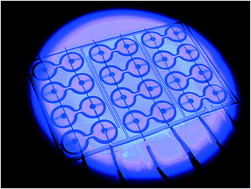Amplification-free detection of DNA in a paper-based microfluidic device using electroosmotically balanced isotachophoresis†
Abstract
We present a novel microfluidic paper-based analytical device (μPAD) which utilizes the native high electroosmotic flow (EOF) in nitrocellulose to achieve stationary isotachophoresis (ITP) focusing. This approach decouples sample accumulation from the length of the channel, resulting in significant focusing over short channel lengths. We provide a brief theory for EOF-balanced ITP focusing under continuous injection from a depleting reservoir and present the design of a short (7 mm) paper-based microfluidic channel, which allows a 200 μL sample to be processed in approximately 6 min, resulting in a 20 000-fold increase in concentration – a full order of magnitude improvement compared to previous paper-based ITP devices. We show the stability of the assay over longer (40 min) durations of time, and using Morpholino probes, we present the applicability of the device for amplification-free detection of nucleic acids, with a limit-of-detection (LoD) of 5 pM in 10 min. Finally, we utilize the small footprint of the channel and show a multiplexed platform in which 12 assays operate in parallel in a 24-well plate format.



 Please wait while we load your content...
Please wait while we load your content...